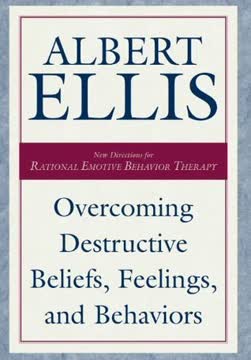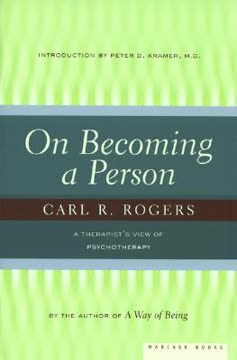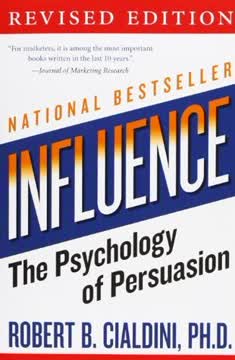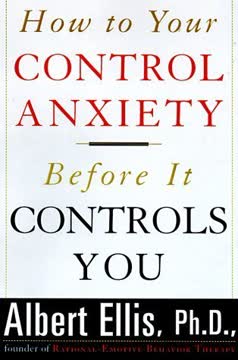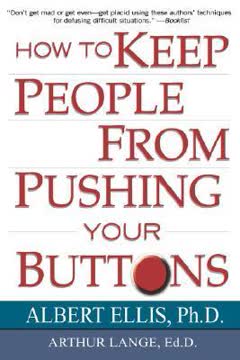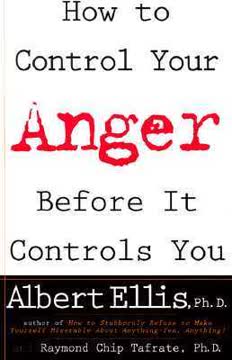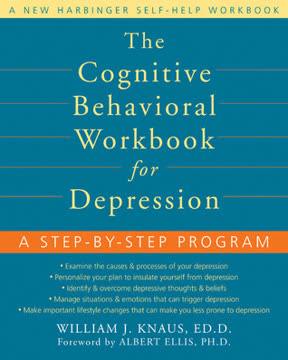Key Takeaways
1. REBT: Rational thoughts lead to rational emotions and behaviors
"REBT holds that when family members become emotionally disturbed or upset at point C (emotional and behavioral Consequence) following a significant Activating experience or Adversity (Point A), A may significantly contribute to but does not actually "cause" C."
Rational thinking as foundation. Rational Emotive Behavior Therapy (REBT) posits that our thoughts, not external events, primarily determine our emotions and behaviors. By adopting rational beliefs, we can significantly reduce emotional disturbances and dysfunctional behaviors.
Practical application. REBT encourages individuals to:
- Identify irrational beliefs that lead to distress
- Replace these with rational alternatives
- Practice new thought patterns consistently
- Observe resulting improvements in emotional well-being and behavior
This approach empowers individuals to take control of their mental health, rather than feeling at the mercy of external circumstances or past experiences.
2. The ABCs of emotional disturbance: Adversity, Beliefs, and Consequences
"REBT holds that, no matter how triggered they are by their genes and by their environments, people largely create their own emotional and behavioral problems."
Understanding the sequence. The ABC model is central to REBT:
- A: Activating event or Adversity
- B: Beliefs about the event
- C: Consequences (emotional and behavioral)
Breaking the chain. By focusing on B (Beliefs), we can change C (Consequences) even when A (Adversity) remains constant. This model helps individuals recognize that their interpretations of events, rather than the events themselves, are often the source of their distress.
Key points:
- Events don't directly cause emotions; our beliefs about events do
- Changing beliefs can change emotional and behavioral responses
- This process gives individuals more control over their reactions
3. Unconditional self-acceptance: You're not your actions
"REBT holds that we'd better not rate ourselves, our essence, or our being, but only our deeds, acts, and performances."
Separating self from behavior. REBT promotes unconditional self-acceptance (USA), encouraging individuals to value themselves as human beings regardless of their actions or achievements. This concept challenges the common tendency to equate self-worth with performance.
Key aspects of unconditional self-acceptance:
- Recognize the inherent worth of all humans
- Evaluate behaviors and outcomes, not the self
- Avoid global self-ratings (e.g., "I'm a failure")
- Embrace fallibility as part of the human condition
By adopting this perspective, individuals can maintain a stable sense of self-worth while still striving for improvement and growth.
4. Disputing irrational beliefs: Challenge your thoughts to change your feelings
"REBT emphasizes the use of scientific method and of logico-empirical disputing to help people change the Irrational Beliefs that encourage self-disturbing."
Active challenging process. REBT teaches individuals to actively dispute their irrational beliefs using logical, empirical, and pragmatic arguments. This process helps to weaken and ultimately replace dysfunctional thought patterns with more rational alternatives.
Disputing techniques include:
- Questioning the evidence for beliefs
- Examining the logic of thought patterns
- Considering the practical consequences of holding certain beliefs
- Exploring alternative perspectives
By consistently practicing these disputing techniques, individuals can develop a more flexible and rational thinking style, leading to improved emotional well-being and behavior.
5. High frustration tolerance: Embrace discomfort for growth
"REBT emphasizes that clients had better have strong intentions to change along with the will to change. Will power, as I have noted, includes the intention, the decision, and the determination to change—and, particularly, the action required to do so."
Cultivating resilience. High frustration tolerance (HFT) is a key concept in REBT, emphasizing the importance of accepting discomfort and difficulties as part of life and personal growth. This approach contrasts with low frustration tolerance, which often leads to avoidance and self-defeating behaviors.
Developing high frustration tolerance involves:
- Recognizing that discomfort is temporary and bearable
- Viewing challenges as opportunities for growth
- Practicing exposure to uncomfortable situations
- Reframing difficulties as a natural part of the human experience
By developing HFT, individuals become more resilient and better equipped to pursue long-term goals despite short-term discomfort.
6. Multimodal approach: Cognitive, emotive, and behavioral techniques
"REBT has always been one of the most behaviorally oriented of the cognitive-behavior therapies."
Comprehensive treatment. REBT employs a multimodal approach, integrating cognitive, emotive, and behavioral techniques to address psychological disturbances. This comprehensive strategy ensures that all aspects of an individual's experience are addressed in therapy.
Key components of REBT's multimodal approach:
- Cognitive: Disputing irrational beliefs, developing rational alternatives
- Emotive: Role-playing, imagery exercises, shame-attacking exercises
- Behavioral: In vivo exposure, skill training, homework assignments
By combining these different modalities, REBT provides a robust framework for addressing psychological issues and promoting lasting change.
7. Accepting reality: Preferences over demands
"REBT holds that when people strongly desire to function productively and happily and when Adversities (A) interfere with their doing so, they have Beliefs (B) about their desires and about their Adversities that result in emotional and behavioral Consequences (C) that are either largely unhealthy and self-defeating or largely healthy and self-helping."
Flexible thinking. REBT encourages individuals to transform rigid demands into flexible preferences. This shift in thinking promotes acceptance of reality while still allowing for goal-directed behavior.
Transforming demands to preferences:
- "Must" becomes "prefer" or "would like"
- "Awful" becomes "unfortunate" or "disappointing"
- "Can't stand it" becomes "don't like it, but can tolerate it"
By adopting this more flexible mindset, individuals can reduce emotional distress and respond more effectively to life's challenges.
8. Active-directive therapy: Therapist as teacher and guide
"REBT is one of the most active-directive therapies, and this also applies to REBT family therapy."
Collaborative learning. REBT takes an active-directive approach, with the therapist serving as both a teacher and a guide. This style contrasts with more passive forms of therapy and aims to equip clients with practical skills and knowledge for managing their emotional well-being.
Key aspects of REBT's active-directive approach:
- Educating clients about the REBT model and principles
- Demonstrating disputing techniques and other coping strategies
- Assigning and reviewing homework
- Providing direct feedback and guidance
This approach empowers clients to become their own therapists, developing skills they can use long after formal therapy ends.
9. Secondary disturbances: Upset about being upset
"REBT holds that when people strongly desire to function productively and happily and when Adversities (A) interfere with their doing so, they have Beliefs (B) about their desires and about their Adversities that result in emotional and behavioral Consequences (C) that are either largely unhealthy and self-defeating or largely healthy and self-helping."
Compound distress. REBT identifies secondary disturbances as a common source of psychological distress. These occur when individuals become upset about their initial emotional reactions, creating a cycle of compounded negative emotions.
Examples of secondary disturbances:
- Anxiety about feeling anxious
- Depression about feeling depressed
- Anger about feeling angry
By addressing both primary and secondary disturbances, REBT helps individuals break free from self-perpetuating cycles of emotional distress.
10. Choice and responsibility: You control your emotional destiny
"REBT holds that they have considerable existential choice."
Personal agency. REBT emphasizes personal responsibility and choice in managing one's emotional well-being. While acknowledging biological and environmental influences, REBT asserts that individuals have significant control over their thoughts, feelings, and behaviors.
Key aspects of choice and responsibility in REBT:
- Recognizing the power to change one's beliefs
- Taking responsibility for emotional reactions
- Actively choosing to work on personal growth
- Embracing the effort required for change
By emphasizing choice and responsibility, REBT empowers individuals to take an active role in their mental health and personal development.
Last updated:
FAQ
1. What is "Overcoming Destructive Beliefs, Feelings, and Behaviors" by Albert Ellis about?
- Core focus: The book introduces Rational Emotive Behavior Therapy (REBT), a cognitive-behavioral approach developed by Albert Ellis to help individuals overcome self-defeating beliefs, feelings, and behaviors.
- Philosophical change: It emphasizes the importance of changing irrational beliefs and adopting unconditional self-acceptance, other-acceptance, and high frustration tolerance.
- Practical application: The book provides detailed cognitive, emotive, and behavioral techniques for addressing a wide range of emotional and behavioral problems, including personality disorders.
2. Why should I read "Overcoming Destructive Beliefs, Feelings, and Behaviors" by Albert Ellis?
- Evidence-based approach: The book presents one of the earliest and most comprehensive forms of cognitive-behavioral therapy, supported by decades of research and clinical practice.
- Self-help and professional use: It is valuable for both individuals seeking personal change and mental health professionals looking for effective therapeutic tools.
- Broad applicability: Ellis applies REBT to individual, group, family, and even organizational settings, making the concepts widely relevant.
3. What are the key takeaways from "Overcoming Destructive Beliefs, Feelings, and Behaviors" by Albert Ellis?
- Irrational beliefs cause distress: Emotional disturbance is largely self-created through irrational, absolutist beliefs and demands.
- Change is possible: By identifying and disputing these beliefs, individuals can achieve lasting emotional and behavioral change.
- Unconditional acceptance: Adopting unconditional self-acceptance, other-acceptance, and high frustration tolerance is central to emotional health.
- Active participation: Lasting improvement requires persistent cognitive, emotive, and behavioral work, not just temporary symptom relief.
4. What is Rational Emotive Behavior Therapy (REBT) as described by Albert Ellis?
- ABC model: REBT is based on the ABC model, where Adversity (A) triggers Beliefs (B), which lead to emotional and behavioral Consequences (C).
- Focus on beliefs: The therapy targets irrational beliefs—absolutistic musts, shoulds, and demands—that lead to unhealthy emotions and behaviors.
- Multimodal approach: REBT integrates cognitive, emotive, and behavioral techniques to help clients change their thinking and actions.
5. How does the ABC model work in REBT according to "Overcoming Destructive Beliefs, Feelings, and Behaviors"?
- A-B-C explained: Activating events (A) do not directly cause emotional consequences (C); instead, it is the beliefs (B) about those events that determine emotional and behavioral outcomes.
- Rational vs. irrational beliefs: Rational beliefs lead to healthy negative emotions (like regret), while irrational beliefs cause unhealthy emotions (like panic or depression).
- Therapeutic focus: REBT helps clients identify, dispute, and replace irrational beliefs to change their emotional responses and behaviors.
6. What are the most common irrational beliefs targeted in REBT, as outlined by Albert Ellis?
- Musturbation: Absolutistic demands such as "I must do well" or "Others must treat me fairly" create rigid expectations and distress.
- Awfulizing: Exaggerating the negative impact of events, viewing them as catastrophic or unbearable.
- Overgeneralization and self-downing: Equating specific failures with being a "bad person," leading to global negative self-ratings and emotional disturbance.
7. What are the three core philosophies REBT encourages, according to "Overcoming Destructive Beliefs, Feelings, and Behaviors"?
- Unconditional self-acceptance (USA): Accepting oneself fully, regardless of successes or failures, without self-condemnation.
- Unconditional other-acceptance (UOA): Accepting others as fallible human beings, without demanding perfection or fairness.
- High frustration tolerance (HFT): Developing the ability to endure discomfort and adversity without catastrophic thinking or avoidance.
8. How does Albert Ellis recommend achieving unconditional self-acceptance (USA) in REBT?
- Directive teaching: Therapists actively teach clients to recognize and dispute conditional self-acceptance, replacing it with USA.
- Emotive techniques: Use of Rational Emotive Imagery, shame-attacking exercises, and role-playing to help clients emotionally internalize USA.
- Behavioral assignments: Clients practice facing feared situations and persistently work on changing self-downing behaviors through homework and real-life exposure.
9. How does "Overcoming Destructive Beliefs, Feelings, and Behaviors" address perfectionism and procrastination?
- Perfectionism as irrational belief: Perfectionism is seen as an absolutist demand for flawless performance, leading to anxiety, depression, and procrastination.
- Cognitive restructuring: Clients are taught to dispute perfectionistic musts and replace them with preferences, reducing performance anxiety.
- Behavioral activation: For procrastination, Ellis prescribes confronting and doing unpleasant tasks despite discomfort, thereby increasing frustration tolerance and reducing avoidance.
10. What are the main cognitive, emotive, and behavioral techniques used in REBT, according to Albert Ellis?
- Cognitive techniques: Identifying and disputing irrational beliefs, using rational coping self-statements, and cost-benefit analyses.
- Emotive techniques: Rational Emotive Imagery, role-playing, humor, and shame-attacking exercises to transform emotional responses.
- Behavioral techniques: In vivo desensitization, exposure to feared situations, skill training, and homework assignments to reinforce new beliefs and behaviors.
11. How does "Overcoming Destructive Beliefs, Feelings, and Behaviors" apply REBT to specific disorders like anxiety, depression, OCD, and BPD?
- Anxiety and depression: Clients are encouraged to face feared situations, engage in pleasurable activities, and dispute catastrophic thinking.
- OCD: Treatment involves disputing rigid beliefs about certainty and control, using exposure, shame-attacking, and behavioral homework.
- Borderline Personality Disorder (BPD): Emphasis is placed on unconditional self- and other-acceptance, frustration tolerance, and gradual skill development, recognizing the biopsychosocial nature of the disorder.
12. What distinguishes REBT from other cognitive-behavioral therapies, according to Albert Ellis?
- Biological and social emphasis: REBT uniquely highlights innate human tendencies toward irrational thinking and the biological basis of resistance to change.
- Active-directive approach: Therapists are highly active and directive, teaching clients to dispute beliefs and practice new behaviors.
- Humanistic philosophy: REBT stresses unconditional acceptance, human fallibility, and the importance of will and choice, integrating cognitive, emotive, and behavioral methods for comprehensive change.
Review Summary
Readers generally find Overcoming Destructive Beliefs, Feelings, and Behaviors valuable, with an average rating of 4.22/5. Many appreciate Ellis's engaging tone and clear ideas, finding the book life-changing. Some criticize repetitiveness but still consider it crucial for psychology students and mental health professionals. Readers praise its introduction to REBT and CBT, along with helpful case studies. Several wish they owned the book for note-taking and highlighting. While some find it challenging, most agree it's an important resource for understanding cognitive therapy.
Similar Books
Download PDF
Download EPUB
.epub digital book format is ideal for reading ebooks on phones, tablets, and e-readers.
